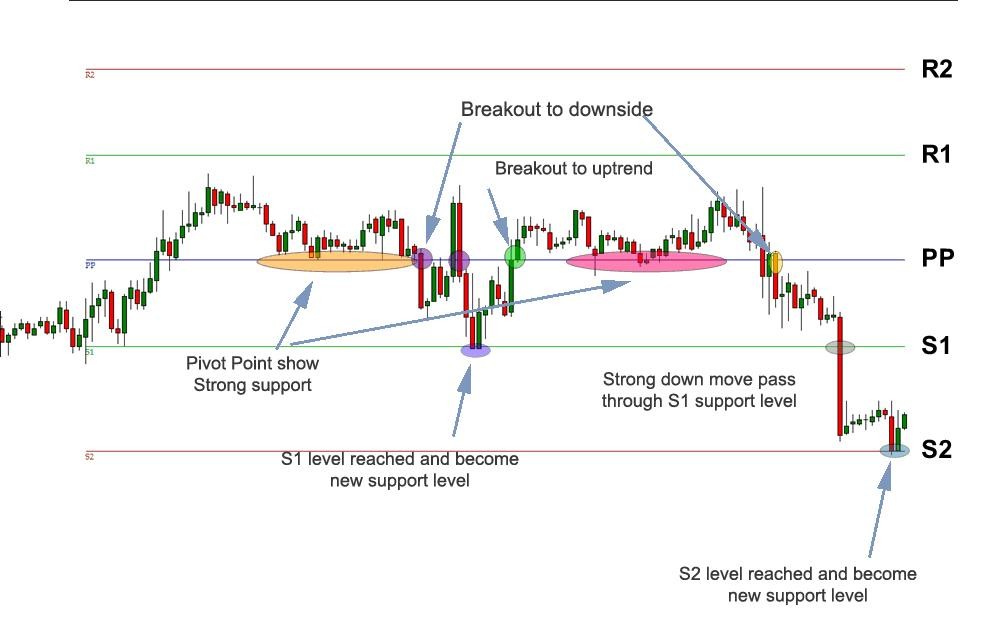Trading with pivot points
Post on: 6 Август, 2015 No Comment

Support and resistance levels often identify price points where major moves take place, but how do you identify support and resistance? Traders use many methods for finding these key areas, including past areas of interest, simple mathematic equations and sophisticated computerized trading models. Often, simple, objective and easily calculated tools are best because they tend to perform consistently over time and work in a wide variety of markets and time frames. One indicator that fits these criteria is Woodie’s pivot point. We will discuss how to calculate, interpret and use this technical tool, focusing on day trading and swing trading.
The Woodie’s pivot point is the level at which the market direction changes for the day. Woodie’s pivot points are used to determine trading levels at which the trend is inclined to change direction and head to possible support and resistance. They are designed to be trend-predicting indicators instead of lagging indicators.
In some ways, pivot points can be a self-fulfilling prophecy. Many traders follow them, which causes the market to react at these levels.
Calculation
In this day and age of instant calculations, it may seem quaint to talk about manual calculation. It’s important when possible to understand the math behind your indicators.
To calculate the Woodie’s pivots use the formulas below. R1-R3 denote resistance levels. PP refers to the pivot point. S1-S3 are support levels. The support and resistance levels that are calculated from the formulas indicate the potential trading ranges for the next trading session.
To calculate the pivot level, we need three prices, which are:
H = Previous day’s high price
L = Previous day’s low price
O = Current day’s opening price
The formula for the pivot point is:
PP = (H + L + (O * 2)) / 4
Support and resistance levels are then calculated. The first support and resistance levels are calculated using the difference between the pivot point and the previous day’s high and low prices:
R1 = (2 * PP) — L
S1 = (2 * PP) — H
The second support and resistance levels are based on the width of the trading range (high — low) and are calculated as:
R2 = PP + (H — L)
S2 = PP — (H — L)
The third support and resistance levels are calculated as:
R3 = H + 2 * (PP — L)
S3 = L — 2 * (H — PP)
These prices are generally taken from a stock or futures contract’s daily chart, but the pivot point can also be calculated using information from hourly charts. Most traders prefer to take the pivots, as well as the support and resistance levels, of the daily charts and then apply those to the intraday charts (for example, hourly, every 30 minutes or every 15 minutes). If a pivot point is calculated using price information from a shorter time frame, this tends to reduce its accuracy and significance.
Analysis
The most important level is the pivot level itself, above or below where the price move will occur toward the support and resistance levels.
It is extremely rare for a stock index to hit its daily R3 or S3 levels. If a market or individual stock rallies until R2 or sells off until S2, this often ends up being the high or low of the day. Knowing this will help temper your emotions and keep you on track to follow this system.
In the context of applying this indicator, we consider the pivot point the trend-deciding level for a particular day. This allows us to derive three basic rules for trading with pivots:
- If the market/stock trades above the pivot point, then the bias for the day is on the long side. Buying is advisable.
- If the market/stock trades below the pivot point, then the bias for the day is on the short side. Short selling would be the preferred strategy.
If the market opens gap up or gap down, and trades near R2/R3 or S2/S3, it will exhibit a tendency to trade back toward the pivot. Thus, the general rule to follow is to “avoid buying the high or selling the low.”
If either of S1 or R1 is penetrated, these breakout points will reverse their roles. That is, the first support (S1) becomes the new resistance (R1).














